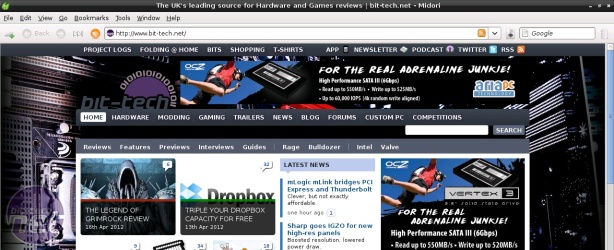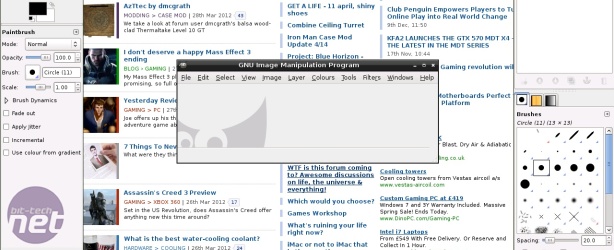Raspberry Pi review
April 16, 2012 | 14:24
Companies: #arm #broadcom #hynix #raspberry-pi #raspberry-pi-foundation

Synthetic benchmarks are one thing, but they fail to answer the real question: is the Pi usable as a general-purpose computing machine?
To get a feel for how the Pi performs as an actual PC, rather than as a development board, we installed the Debian Linux distribution with the lightweight LXDE desktop environment. By default, Debian boots into a text-based terminal with a boot time of just 13 seconds from cold using a Transcend Class 10 SD card.
From here, it takes approximately eight seconds to load the LXDE desktop - at which point the system is ready for use. Loading the Midori web browser from the desktop takes around six seconds, plus a further eight seconds to load the bit-tech homepage.
If you're not impressed by a twelve-second load time for a lightweight web browser, remember that this is being performed by a device running on a 5V 1A power supply and taking up no more room than a short stack of business cards.
Once loaded, the lack of hardware accelerated video starts to bite: scrolling on more complex pages is painful, taking a good couple of seconds to get started and then skipping down the page in an extremely jerky fashion. Once hardware accelerated drivers are bundled with the distribution, however, this is likely to improve dramatically.
Loading a more complex program, The Gimp, really stretches the Pi's CPU: first load took 87 seconds, while subsequent loads - which skip the 'querying plug-ins' step - took an average of 43 seconds. Not too shabby, but a far cry from the sub-ten seconds the same program takes to load on a desktop machine.
It's when loading The Gimp and other more complex programs that you realise why the various Linux distributions for the Pi have a CPU monitor somewhere on the taskbar: without a graph showing the CPU maxing out, it's all too easy to wonder if the delay is because you didn't double-click fast enough or whether the system has hung altogether.
In short: it's perfectly possible to use the Raspberry Pi as a day-to-day machine, so long as you're fairly patient.
To get a feel for how the Pi performs as an actual PC, rather than as a development board, we installed the Debian Linux distribution with the lightweight LXDE desktop environment. By default, Debian boots into a text-based terminal with a boot time of just 13 seconds from cold using a Transcend Class 10 SD card.
From here, it takes approximately eight seconds to load the LXDE desktop - at which point the system is ready for use. Loading the Midori web browser from the desktop takes around six seconds, plus a further eight seconds to load the bit-tech homepage.
If you're not impressed by a twelve-second load time for a lightweight web browser, remember that this is being performed by a device running on a 5V 1A power supply and taking up no more room than a short stack of business cards.
Once loaded, the lack of hardware accelerated video starts to bite: scrolling on more complex pages is painful, taking a good couple of seconds to get started and then skipping down the page in an extremely jerky fashion. Once hardware accelerated drivers are bundled with the distribution, however, this is likely to improve dramatically.
Loading a more complex program, The Gimp, really stretches the Pi's CPU: first load took 87 seconds, while subsequent loads - which skip the 'querying plug-ins' step - took an average of 43 seconds. Not too shabby, but a far cry from the sub-ten seconds the same program takes to load on a desktop machine.
It's when loading The Gimp and other more complex programs that you realise why the various Linux distributions for the Pi have a CPU monitor somewhere on the taskbar: without a graph showing the CPU maxing out, it's all too easy to wonder if the delay is because you didn't double-click fast enough or whether the system has hung altogether.
In short: it's perfectly possible to use the Raspberry Pi as a day-to-day machine, so long as you're fairly patient.

MSI MPG Velox 100R Chassis Review
October 14 2021 | 15:04










Want to comment? Please log in.